We began reading defenders with our receivers a couple years ago. This is commonly known as the Seam Read and utilized by slot receivers. The thoughts going through our coaching minds were just like every other coach when adopting something that is considered advanced or next level:
- Can our receivers make the read on the run?
- Can our QB get on the same page with our receiver’s decisions?
- How expensive and time consuming will this concept be? Practice time is valuable and do we have the time to commit to this principle?
- How do these principles apply to our current offense and what will we need to change?
These questions were answered very quickly. Our receivers could do it, our QB could get on the same page, it was not very expensive and we replaced the 'air raid' concepts we had been running for some run and shoot concepts that already used these principles. In order to simplify the concept, we adopted some simple “run and shoot” rules that allow our guys to focus on one player (the key defender) rather than actually reading the coverage. This was dubbed a “poem” route by our receivers coach due to the nature of the simple poem of rules we adopted to teach our kids.
The Poem route focuses on the key defender and is as follows:
“If he is even, I’m Leaving
If he’s dropping, I’m Stopping
And if he crosses me, I cross him.”
The poetic nature of these rules made them very easy to remember and our kids caught on very quickly. We were impressed with how quickly they caught on, because we were very worried about our guy’s ability to make the right decision. Over the course of the past two years, our guys have made the right decision most of the time. This poem route concept is used on at least one route in most of our offensive passing concepts.
Breaking down the “Poem” Route
One key point is the receiver makes his decision at a designated yard mark. This is normally 8 or 10 yards depending on the play and where the receiver fits into the QB’s progression. In the diagram above, the final decision point is at 10 yards.
“If he’s even, I’m Leaving”
This part of the poem route discusses the “cushion” or separation being created by the defensive back between the receiver and the DB. We teach our receivers to try and “step on the toes” of the defensive back and break the cushion. In practice, if the WR would be able to step on the toes of the DB, then the DB would at least be “even” with him and we can beat that guy deep so the WR would “leave” the DB. These become explosive plays and touchdowns in our passing game. We leave it up to the WR to decide if he can beat the defender deep. We have found that the receiver usually does a very good job with this decision because he wants the ball and knows that the QB has to also see the cushion broken. In this scenario, the WR will communicate with the DB by ‘throwing his flag’. This is simply raising his inside arm above his head and waiving it once. This is vitally important so the QB knows where to throw the ball.
If he’s dropping, I’m stopping”
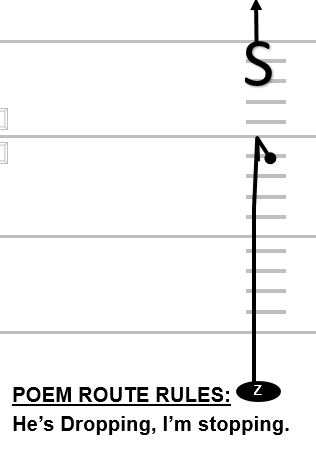
This part of the poem route also discusses the “cushion” or separation being created by the defensive back between the receiver and the DB. If the defensive back does a good job keeping his cushion and the WR cannot “step on his toes”, the WR will simply stop his route, turn to the inside and hitches up showing his numbers to the QB. This happens more times than not, because DB’s have the “don’t let anybody deeper than you” beaten into their brains by DB coaches across the country. This is okay with us because it becomes a very easy completion compared to the low percentage deep throw.
Stopping would look like the diagram to the left on a Seam Route, although the WR does have the latitude to slide into an open window.
If he crosses me, I cross him.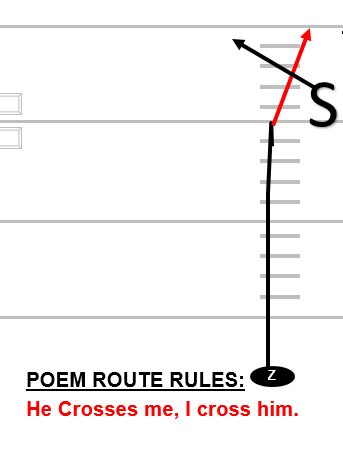
This part of the poem route describes when a defender may cross the receiver in order to get into a 2-Deep zone area. In this case, the WR will ‘cross’ the defender order to get inside of him and into the middle of the 2 deep safeties. After the WR crosses, he will get back to vertical as much as possible. The QB will normally throw the WR into the open space rather than the receiver sprinting into the middle of the open zone on his own. This happens because the QB knows where the opposite seam defender is and will want to throw the ball away from him. This has occurred some for us, but not very often because of the coverages we seem to face on a weekly basis. This is another ways an explosive play can happen and helps create an easier throw for the QB.
What play concepts are poem routes used?
The ‘poem’ route can be used within any passing concept in which a receiver has a vertical route that is not designed to clear a defender. What I mean by this, is if we want to run our curl route out of 3x1, we would have a receiver run a vertical route in order to clear the deep defender that may sit on the curl. In this case, we would not give him the option of the poem because he would be in the way.
Streaks
4 Verticals is a very simple way to add a poem route. In this case, we would tag one receiver to run the poem route. You can tag any receiver you choose. In the diagram below, the H is tagged with the poem route, but any receiver can be tagged depending on game plan. You could even have both inside receivers always run seam read poem routes of 4 verticals. This is especially good when facing a 2 high safety team that may run Quarters and Cover 2.
Switch
On the switch route, both receivers will utilize the poem route rules. The only difference is the Inside receiver that goes out will only have the option to leave or stop.
Go Route
On the go route concept, the #2 receiver call side will run the seam read poem.
Choice Concept
On the Choice concept, there will be a poem route included to the trips side. 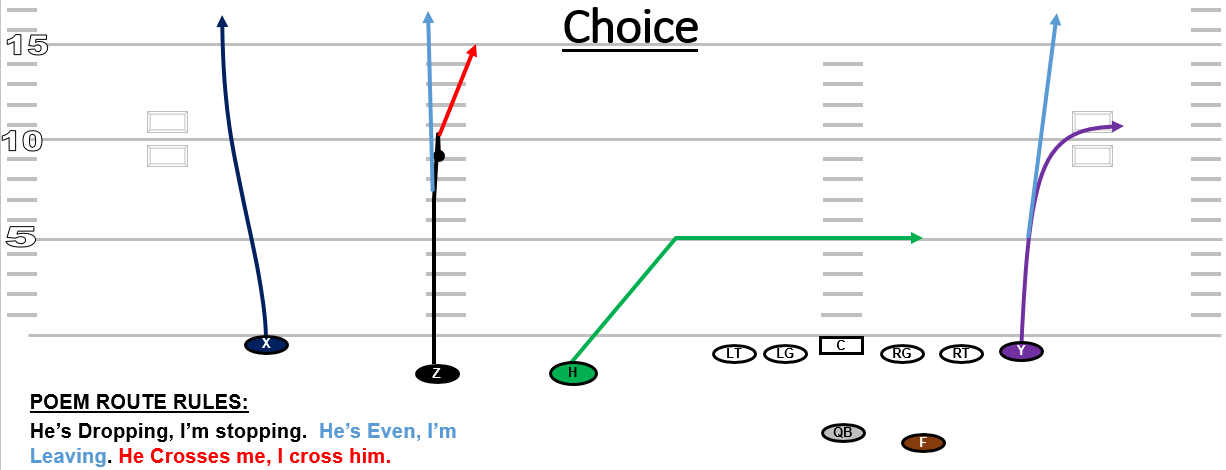
As you can see, the poem route is simply added to each passing concept. It has been very beneficial because when done correctly, the defender cannot be right. Hopefully this principle can be added to your offense and be beneficial to you in some way.
Thanks for reading.
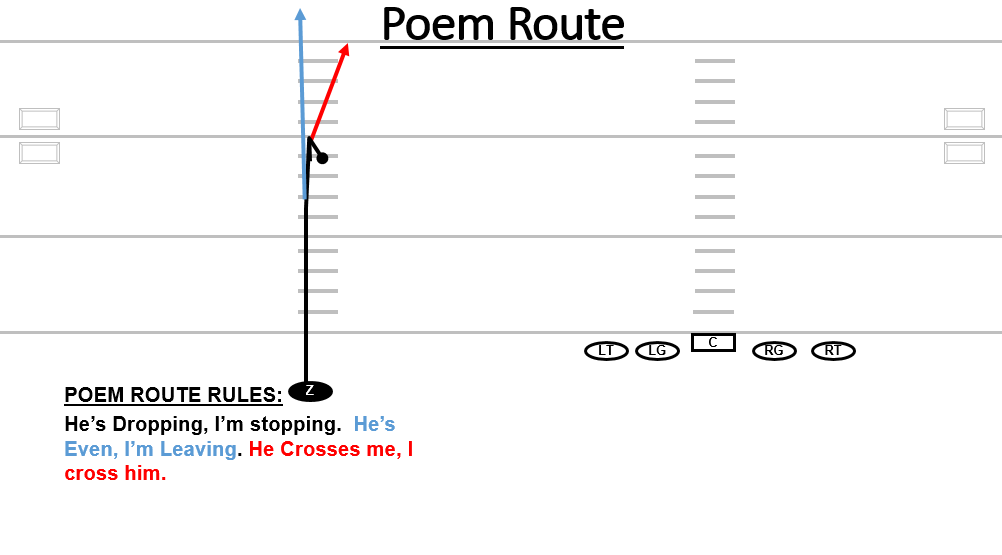
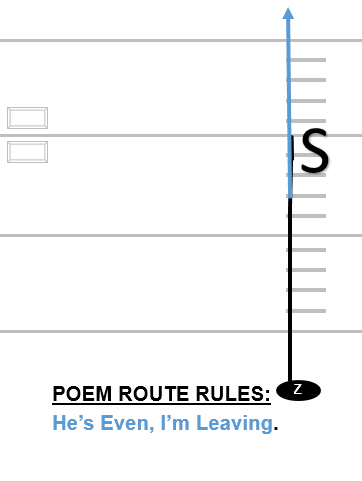
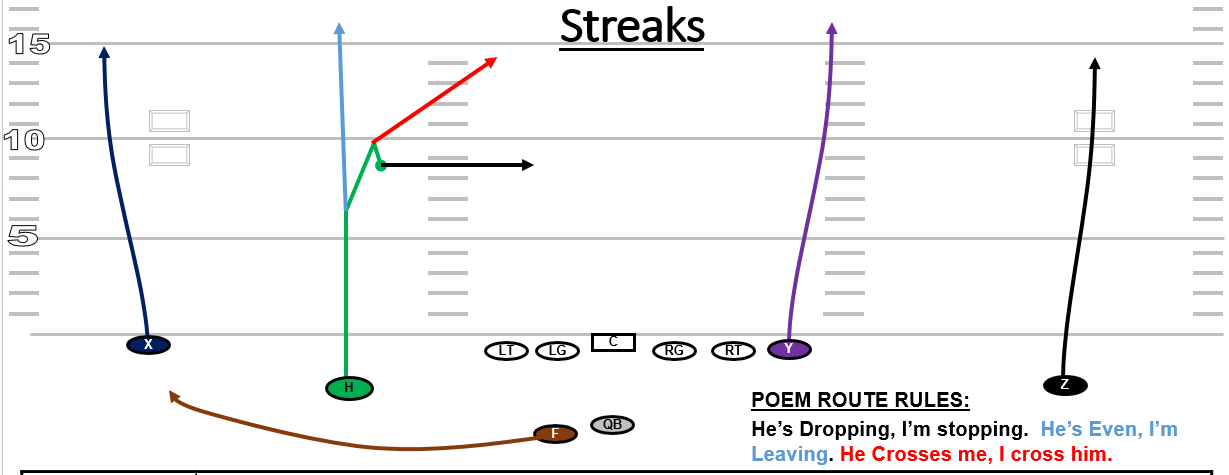
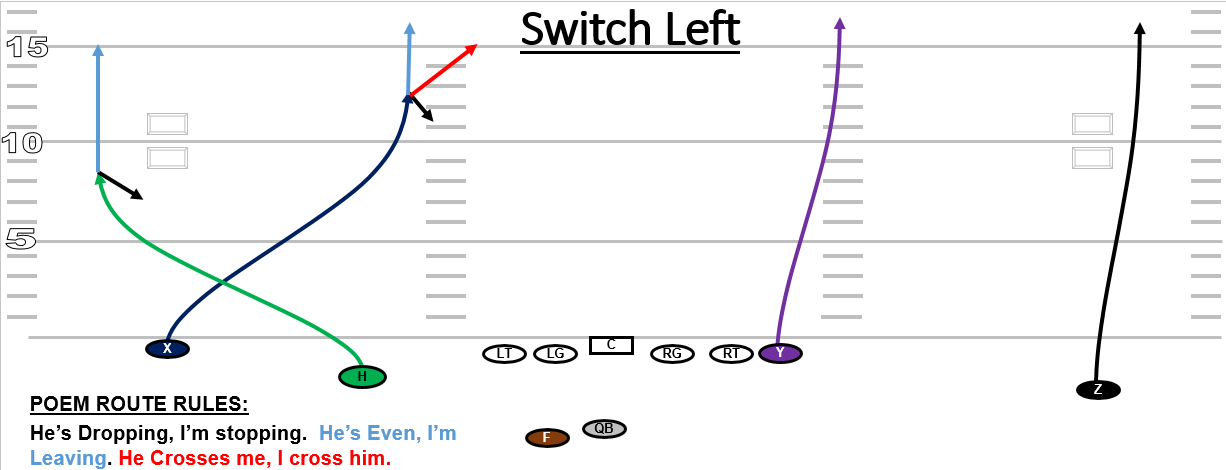
Great article coach. I love the Run and Shoot and I think it is better suited to attack the Pattern reading defenses of today. How do you go about drilling the Poem route?
Thanks coach. I agree about the Run and Shoot Concepts. Since we switched, our passing game has improved a ton. We drill the poem route 2 ways. First, during installation, we will use the seam and a coach will stand 8 or so yards away and about a yard inside a line of receivers. The coach will do one of 3 things, 1. backpedal (Keep cushion), 2. sit still (allow cushion to be broken), or 3. cross the player (run to the deep half). During teaching, we will do one read at a time over and over again. After our guys understand and have repped the route adjustment, we will mix it up on them. After the teaching period, when we rep this route, we just have a receiver stand in as the defender (instead of the coach) and the kids rotate from receiver running the route, to the defender, to the end of the line.
Once the route has been installed and repped, we mainly use our ‘routes on air’ period to work on our poem route adjustments. This way we are practicing our passing concepts, while still working our adjustments. We do this the same way as above, 2 receivers will snap to the QB’s and 1 or 2 receivers will stand in as the defender(s) depending on the concept. Switch, we will use two defenders because both receivers need to key a defender. Other concepts, we will only use 1 defender because there is only 1 poem route. This defender is not supposed to make a play on the ball because routes on air is a confidence drill for us. We want to run the right routes complete all of our passes. The defender is only there to give the receiver a visual key.
Coach Lickert,
Thanks for responding. I love the Run and Shoot, and like you, I’m moving our passing game to it. Would you be willing to share your practice schedule and some cut-ups of your offense with me?
How are you finding the Go concept working out of Shotgun? Everything I’ve read about the concept says that it isn’t as effective in the Shotgun as it is under center. Do you run Slide at all?
We’ve just started to rep the Poem route were I am at. The kids seem to pick it up easy. I have given the outside WR the same read as the Poem route – when running Streak or Switch – and have found the defense doesn’t know how to react. Do you do something similar?
Coach McKie,
I can send you some info. We did struggle some with the Go Route timing early, but we changed the Go Route to a progression read and it helped. We also became less worried about how close the #2 and #3 receivers were at the start of the play. I wrote about it here https://www.completeheadcoach.com/run-shoot-go-route/ . We have not run slide, but have discussed adding it in the spring.
On Switch, both switch receivers are following poem rules. On Streaks, we will tag any receiver to run the Poem route. It will sometimes be the outside guy, but we don’t give them all freedom on every play. We really don’t have a good reason why other than we utilize some other tags on our streaks play that make it necessary for the other receivers to clear out and run deep. It is a good idea and something we may experiment with this spring.
Coach,
I’d love to see some of your cut ups. Thank you. I’d love to see your cut ups for Choice, Steak, and Switch. I want to show my guys what it should look like. Where do you coach at? I love to see the Run and Shoot slowly making a come back.